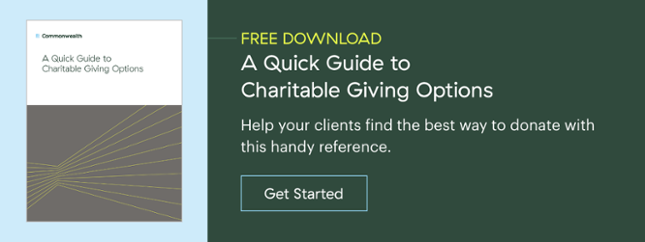 Today is GivingTuesday, a worldwide event dedicated to celebrating the spirit of generosity and unleashing the power of philanthropy. To honor this cause, I’d like to discuss how you can make a profound difference in the world by establishing philanthropy as a cornerstone of your practice. Many advisors tell me that helping clients fulfill their philanthropic goals is highly meaningful. For these advisors, a formative experience or event sparked a lifelong passion to give back to their communities.
Today is GivingTuesday, a worldwide event dedicated to celebrating the spirit of generosity and unleashing the power of philanthropy. To honor this cause, I’d like to discuss how you can make a profound difference in the world by establishing philanthropy as a cornerstone of your practice. Many advisors tell me that helping clients fulfill their philanthropic goals is highly meaningful. For these advisors, a formative experience or event sparked a lifelong passion to give back to their communities.
I understand their passion because I feel it, too. For me, the formative experience was the unforgettable kindness and gratitude that greeted me when, as a teenager, I helped organize and deliver a truckload of supplies to the Engine 33 Ladder 9 firehouse in Lower Manhattan after the 9/11 attacks. Since then, giving back to my community has been an important part of my life—and my work with advisors.
It’s likely many of your clients and prospects have experienced formative moments that shaped their core values around the spirit of charitable giving. Discussing these experiences will help you build strong relationships with your clients and community of prospects. You may find you can guide your clients’ passion for philanthropy to create a far-reaching impact on the world. And there’s no better way to amplify your spirit of generosity than by guiding your clients in giving.
Tax savings aren’t the primary motivator for many donors; instead, they believe in the causes they support, often due to a personal connection. By focusing on your clients’ philanthropic purpose, you can direct them to the most meaningful giving opportunities. But how do you uncover those motivations? And how do you apply them to an impactful giving plan?
One effective method is to employ the concept of the planning horizon, as explained by Todd Fithian and Scott Fithian in their book, The Right Side of the Table. According to the Fithians, conversations that take place above the horizon address your clients’ deepest and most personal intent for their wealth. Conversations below the horizon focus on the products and strategies that can achieve their charitable giving goals.
Your conversations about philanthropy should primarily take place above the horizon. Studies have shown that high-net-worth clients like to discuss philanthropy within the first few meetings with an advisor. To incorporate philanthropy into your practice, begin by adding these questions about charitable giving to your client intake forms:
- Which organizations do you support each year?
- How much do you give to each organization?
- Do you write a check or donate assets?
During meetings with philanthropic clients, dig deeper by asking questions such as:
- What is the mission of an organization you support?
- What is your connection to the cause?
- What impact would you like to have on your community?
- How would you like your wealth to create change in our society?
These questions will allow clients to really open up about why certain causes are significant to them. The insight you gain will inform and align all of the planning you do for individuals. Ultimately, you’ll be able to create meaningful, holistic strategies for your clients.
Asking these deep and sometimes hard-hitting questions requires a great deal of trust between you and your clients. To build that connection, start by demonstrating your expertise and providing accurate information. Next, do what you say you will—and do so with the quality of effort you’ve promised. Always be willing to ask the tough questions, but be sure to be empathetic and relatable. Last, but certainly not least, always put your clients’ interests ahead of yours.
Of course, conversations will eventually dip below the horizon to a discussion of the charitable giving vehicles that will achieve the desired effect, all while fitting into the overall financial plan. You should be familiar with the “hows” of charitable panning, including the use of private foundations, donor-advised funds, charitable trusts, and direct gifts. In addition, even if tax efficiency isn’t the primary motivation for giving, it’s vital to understand—and be able to explain—the tax impact of gifts.
You may wish to be involved in your clients’ discussions with their prospective charitable recipients. You’ll want to confirm how the planned gifts will be used and establish mechanisms to measure their impact. Ultimately, by establishing philanthropy as a cornerstone of your practice, you can build deeper relationships with clients and their families, friends, and network. Most important, you and your clients will have the satisfaction of adding to the spirit of charitable giving throughout the communities we all share.
Do you include charitable giving discussions as part of your client intake form or client meetings? Have you established philanthropy as a cornerstone of your practice? Please share your thoughts with us below.




